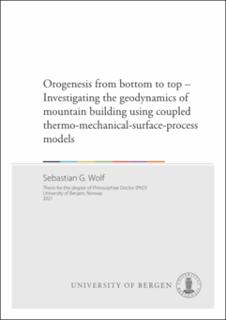| dc.description.abstract | The objective of this project is to The objective of this project is to advance our understanding of mountain building processes in different plate tectonic settings and with specific focus on the interaction between surface processes and tectonics. Three topics are investigated:
1. The factors controlling overriding plate extension or shortening in ocean-continent subduction systems.
2. The evolution of continent-continent collision orogens from small to large, their typical distribution of shortening, variable structural style, and associated controlling factors.
3. The relation between surface processes and tectonics during orogenic growth and decay and the factors controlling height, width, and longevity of collisional mountain belts.
The three research aspects are investigated with the help of numerical models and comparison to natural examples. The newly developed models allow for the first time to efficiently model the coupling between tectonic deformation, erosion and deposition. Results are synthesized in published or submitted articles, provide new geodynamic relationships, ideas, and theory, and simplify understanding of mountain building on Earth.
For topic 1, we use two-dimensional thermo-mechanical models, and show that back-arc extension or shortening of the overriding plate in ocean-continent subduction systems is determined by absolute plate velocities on Earth: Overriding plate movement towards the trench inhibits backarc extension and promotes overriding plate shortening, and a stable overriding plate or absolute plate movement away from the trench promote backarc extension. Additionally, a weak backarc lithospheric mantle, removed through Rayleigh-Taylor instabilities induced by the subduction process, is required for backarc extension and facilitates overriding plate shortening. Computation of driving and resisting forces during orogenesis shows near-balance of forces and explains why a weak and thinned backarc lithospheric mantle is pivotal for backarc extension and shortening. Comparison of model results with the Andes and Hellenic subduction zones corroborates that a weak and thinned backarc lithospheric mantle and absolute plate velocities determine overriding plate deformation.
In topic 2, we use two-dimensional thermo-mechanical continent-continent collision models tightly coupled to a 2D surface process model and show that distribution of shortening during orogen growth follows a typical evolutionary pattern from a pro-side-dominated cold wedge to an orogenic plateau. Internal crustal loading is the main factor controlling the large scale deformation, while lithospheric pull only modulates the plate driving forces to sustain orogenesis. To first order surface processes delay orogenic growth, and modulate the structural style during growth. Utilizing a force-balance analysis, we show how inherited structures, surface processes, and decoupling between thick-and thin-skinned deformation influence the structures during orogenic growth. Comparison of generic model results with the Pyrenees, Alps, and Himalaya-Tibet shows applicability and limitations of model inferences.
For topic 3, we use two-dimensional thermo-mechanical continent-continent collision models tightly coupled to a 2D surface process model and show that orogenic growth and decay depend on crustal rheology and surface process efficiency, and can be subdivided into two phases each. In growth-phase one, orogens grow primarily in height, followed by lateral growth in phase 2. Depending on surface process efficiency, phase-2-orogens can be classified into three types (Type 1, 2a, 2b): Type 1 orogens are not in flux-steady state, and are characterised by longitudinal valleys in the orogen core and low uplift and erosion rates. Flux-steady state, pre-dominantly transverse river flow in the orogen core and high uplift and erosion rates are characteristic for type 2 orogens. These orogens can furthermore be subdivided into types 2a and 2b, depending on whether the pro-side of the mountain belt produces significant thrust sheets. Based on model results, we derive an analytical scaling relationship of mountain belt growth and present a new non-dimensional number, $Be$, that describes the interaction between surface processes and tectonics during orogenic growth, and allows approximation of crustal strength and average fluvial erodibility of orogens on Earth. Finally, we use our scaling relationship and model inferences to compare to several orogens on Earth, specifically the Southern Alps of New Zealand, Taiwan, and Himalaya-Tibet. Our model inferences imply that the height of most growing orogens on Earth is controlled by the crustal strength of the foreland, and not by surface processes efficiency. In contrast, orogenic decay is primarily dependent on surface process efficiency. In decay-phase one, short-wavelength "tectonic" topography is quickly removed within few Myrs, before an effectively local-isostatic rebound creates slow decay of topography, with a timescale depending on surface process efficiency. We conclude that survival of orogenic topography for several tens to hundreds of Myrs is likely the default behaviour on Earth. | en_US |
| dc.relation.haspart | Paper II: Sebastian G. Wolf, Ritske S. Huismans, Josep-Anton Muñoz, Magdalena Ellis Curry, Peter van der Beek. Growth of collisional orogens from small and cold to large and hot - inferences from geodynamic models, Journal of Geophysical Research: Solid Earth 126(2), e2020JB021168. The article is available at: <a href=" https://hdl.handle.net/11250/2766529" target="blank">https://hdl.handle.net/11250/2766529</a> | en_US |

